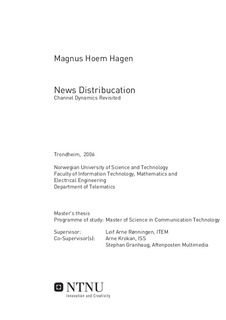| dc.description.abstract | Today, media companies seek to utilize a set of channels. We have taken a systems approach to these companies channels that is, the different channels interact dynamically to form a product s whole. The report deals with channel systems consisting of print, online and mobile channels. We have identified community services as a major driving force in pushing the print/online channel system towards a steady state. Community services have enabled what we call mature online services. These emergent services are characterized by a differentiation process; they have channel specific facilities, tailored for that particular channel s form factors, habit factors, media type support, level of interactivity, etc. Our case studies indicate that as a product s properties get more mutually differentiated, it becomes possible to design emergent channel systems based on complementarities. Lesernes storbytips , our first case study, illustrates how such cross-channel designs can be achieved in real products, based on a system consisting of a print and an online channel. Throughout the report, we have argued that complementary thinking in some cases contrasts existing views; most notably, a view characterized by substitution. So far, the introduction of a mobile channel has, at least as far as news organizations are concerned, been characterized by substitution rather than complementation. We want to follow our complementation credo when a mobile channel is present in the system as well. In our report, this is applied in the second case study. Here, we explore a community music service similar to Myspace and NRK s Urørt, only with a different set of channels. The result is a channel system that forms an enclosed circle from the user and back. One might claim that the deployment of the mobile channel and channel systems in general are coloured by organizational structures. News companies have established subsidiaries to run new media businesses. A separated new media organization has undoubtedly helped in maturing online news sites, and we obviously do not want this process reversed, as differentiated properties are the main foundation for cross-channel complementation designs. Nevertheless, this report is pervaded with the view that a more overall, integrated, process is favourable for channel strategies, especially as new channels are added to the system and they become more complex. | nb_NO |

